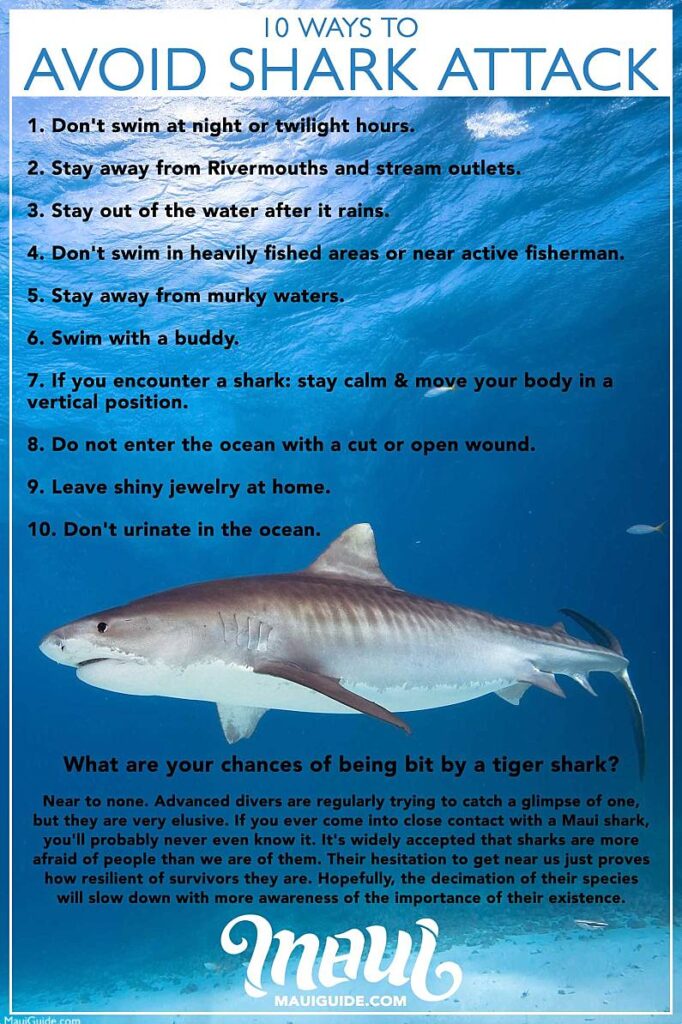Maui > Nature > Sharks > Species

Species of Hawaiian Sharks
Parts of a Shark • Reef-Slope Predator • Ancient Fossils • Hawaii Shark Attacks
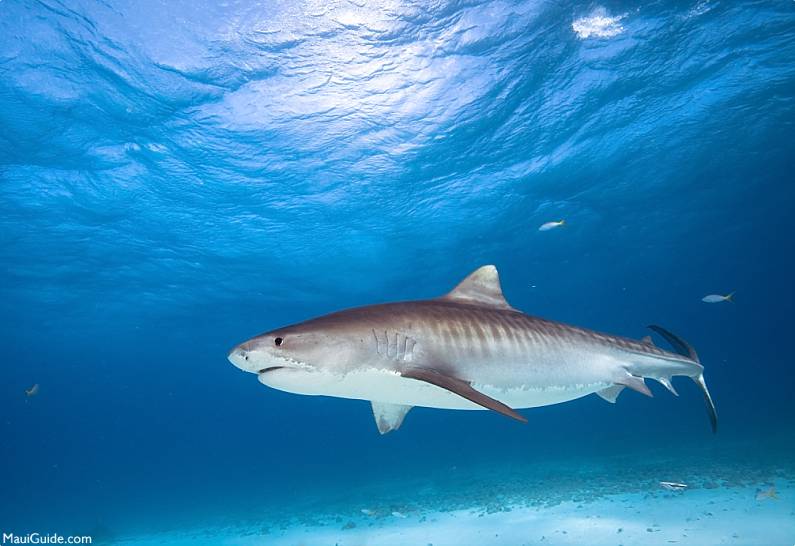
Hawaiians & Sharks
To Hawaiians, mano (Sharks) are considered ʻaumakua (family or personal gods.) Often, a departed ancestor took the form of a shark after death and appeared in dreams to living relatives. Hawaiians who had a shark as their ʻaumakua did not eat sharks, and provided food to a special shark thought to be the relative.
Not all sharks are ʻaumakua. However, many modern Hawaiians feel very uncomfortable when sharks are killed, even after an attack on humans occurred. Although the present-day Hawaiians don’t pay “homage” to the shark ʻaumakua, the ancestral association still exists. Their logic is, “if my ancestors worshipped the mano, then we should at least respect it as part of our cultural past if Hawaiʻi is to remain Hawaiian.” Quote from Charles Kauluwehi Maxwell Sr., Honolulu Advertiser
Sharks played a very important role in the lives of the ancient Hawaiian people. Hawaiʻian chants tell of the shark’s assistance in the first migration to Hawaiʻi. A huge shark named Kamohoaliʻi, the brother of the volcano goddess Pele guided the double hull canoes to Hawai’i. The shark was deified in stories and chants and many believed it possessed supernatural powers.
25 Best Things To Do On Maui
Occasionally shark attacks occur in Hawaiʻi. In almost every incident, the attack could have been prevented if the logic of the ancient Hawaiians was observed (as stated below.)…
“If the water is rough, and is murky, stay out of the ocean because sharks are most likely in the area. They tend to come around in this condition when food is plentiful, as fishes and turtles usually feed under these conditions. Stay away from the mouths of rivers. Usually, dead animals wash down from the mountain and the sharks are the ones that keep the ocean clean.” – Charles Kauluwehi Maxwell, Sr.

Parts of a Shark
Shark Eyesight
In poor light or limited visibility, a shark’s eyes are ten times more sensitive than those of humans. The eyes of sharks contain a special mirror layer called the ‘tapetum lucid’. This layer is also present in the eyes of nocturnal animals, such as cats. This reflective layer enables sharks to effectively hunt at night.
Shark Smell
The shark has been called the “nose of the Sea” since smell ranks second in sensitivity among the shark’s various senses. Sharks can detect odors at a distance of about 500 years and are also able to detect minute concentrations of odors. A shark can smell a single drop of blood in an Olympic-sized swimming pool!
Shark Teeth
Unlike most other fishes whose teeth are “fixed” in their jaw, sharks’ teeth can be replaced indefinitely. Several sets of reserve teeth can be seen sitting behind the front rows. If one or more of the front teeth are lost another will move up to replace it. An individual shark may replace thousands of teeth during its lifetime.
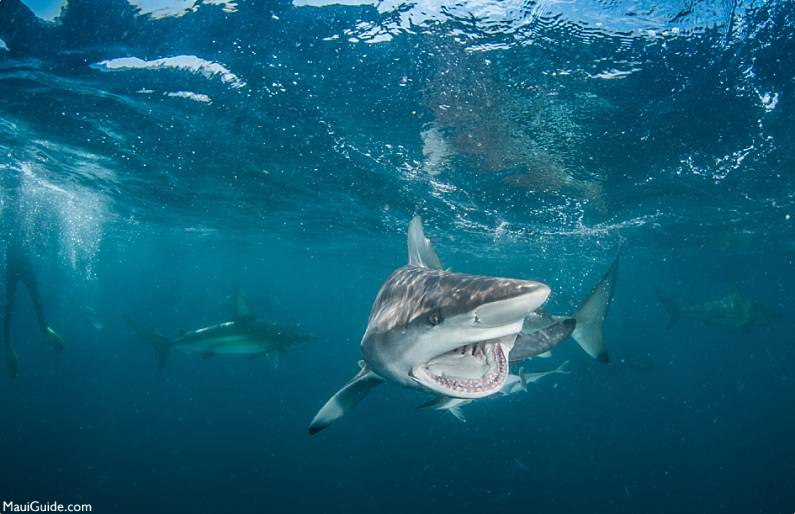
Lateral Line
You can see a line that runs from the head to the tail along the upper part of each shark’s body. This line is called the lateral line. It contains millions of tiny cells that are specially designed to detect vibrations in the water. The lateral line is extremely sensitive and is able to detect movement in the water from several hundred yards away. The lateral line enables a shark to detect a fish resting beneath the surface of the sand by the vibrations produced by its heartbeat!!
Shark Skin
Sharks’ skin is unique: tough, abrasive, and composed of tiny, hard, tooth-like scales called denticles. These denticles are structurally similar to shark teeth. As sharks grow, the denticles are shed and replaced by slightly larger ones. Denticles break up water flow, improving a shark’s swimming efficiency by overcoming drag from the water. They also help stave off unwanted bacteria growth. The tiny texture patterns on each denticle cause enough variation to keep large populations of bacteria from growing in 1 place. This unique pattern is being adopted by scientists into new surfaces to be used in hospitals and other locations where bacteria growth is a danger.
Electrical Fields
The most unique method of prey detection used by sharks is their ability to sense the electrical fields given off by all living things. The organs that detect these fields are called the “ampullae of Lorenzini.” They can be seen as small dots on the underside of the shark’s nose. Ampullae allow sharks to detect other animals which are lying motionless, in total darkness, or even buried under the sand. It appears that sharks may also use this electrical sensitivity to navigate, as they are able to detect the Earth’s magnetic field and position themselves in relation to it. This is similar to having an in-built compass.
Reef-Slope Predator
Mano paʻele (Blacktip reef shark), named for the black tips on its fins, is generally found inshore in shallow water. These timid sharks are common throughout the tropical oceans of the world and feed on fishes, crabs octopuses, and squid. They can grow to 6 feet in length but are usually less than 4 ft.
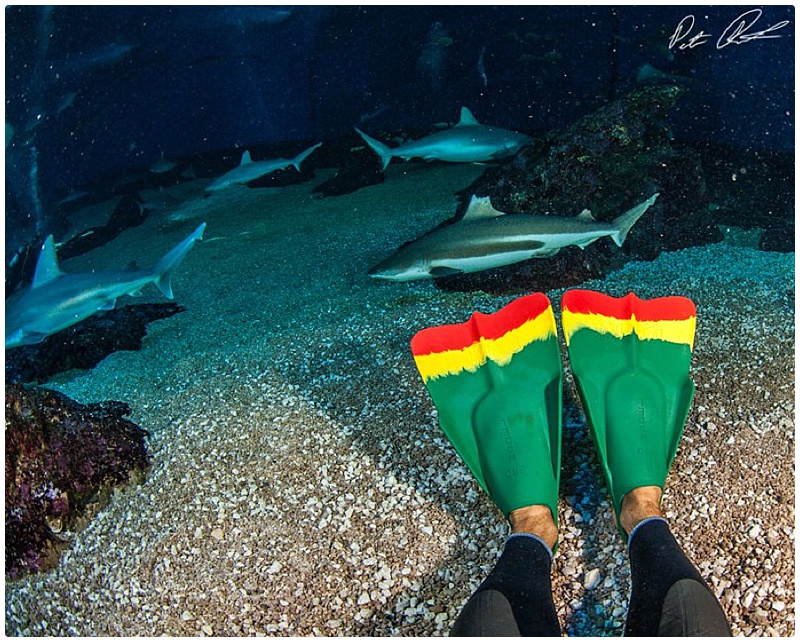
Sharks are thought to have evolved from armor-plated marine animals about 400 million years ago. Sharks, as we see them today, first appeared about 250 million years ago. A shark’s skeleton is made entirely of cartilage. They have no rib cage and are easily injured. Sharks lack the swim bladders common in most other fishes, and without them to control buoyancy, tend to sink if they stop swimming. Some sharks can pump water over their gills allowing them to rest on the ocean bottom, but most must whim to maintain a flow of water over their gills.
Sharks have widely varying diets, which include everything from whales to coral spawn. Of the 350 species of sharks known, only around 50 have ever attacked humans.
Ancient Fossils
Sharks are the oldest group of jawed fishes alive today, with a fossil record dating back about 450 million years. This is well before the first reptiles (around 300 million years ago), and the first mammals (around 210 million years ago) made their appearance on Earth.
The first sharks had elongated bodies and large triangular fins and a mouth full of teeth similar to modern sharks. Over the eons, numerous families of sharks evolved, many became extinct, while others survived. While the fossils of some modern families of sharks go back 150 million years, most of the 800 species of sharks, rays, and skates appeared within the last 50 million years.
Sharks are found in every part of the ocean, from the bright sunlit coral reef to the perpetual night of the deep seafloor. Sharks do not make good fossils. When ancient sharks died, their cartilaginous skeletons disintegrated leaving only the teeth and occasional vertebrae to fossilize. The oldest known shark tooth fossils were found in Spain and are about 400 million years old. One of the oldest species of shark was the Cladoselache, which appeared 375 million years ago.
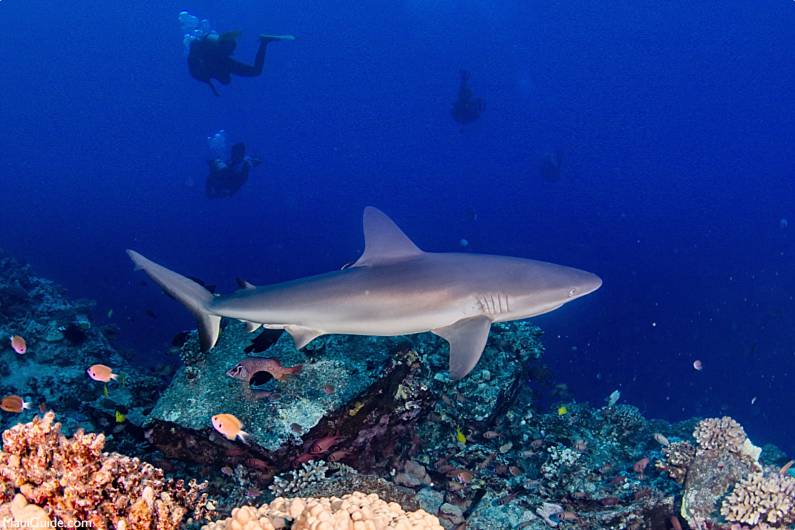
The above information about Hawaiian Sharks is used courtesy of the Maui Ocean Center.
